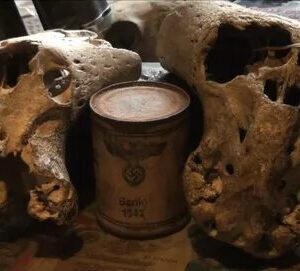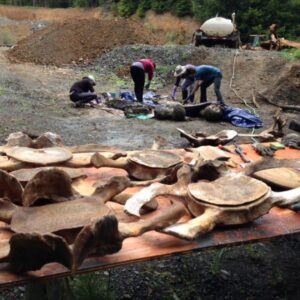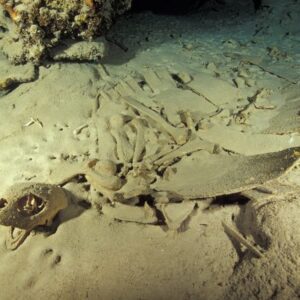Scientists have revisited one of the oldest prosthetic body parts in human history – a 3,000-year-old wooden toe.
A new study of the toe – using techniques such as microscopy and X-ray imaging – has revealed it was re-sized several times to fit the foot of its owner, a priest’s daughter.
Research on the toe also suggests that the priest must have been wealthy, due to the quality of its construction.
Scroll down for video

The experts have reevaluated one of the oldest prosthetic body parts in human history, shedding new light on a 3,000-year-old wooden toe (purported). This toe was discovered in the necropolis of Sheikh Abd el-Qurna in Egypt. They used advanced techniques like high-powered microscopy, X-ray technology, and computed tomography (CT) scans to explore the external surface and internal structure of the toe.
The delicate process revealed that the prosthetic toe had been delicately modified to suit the exact measurements of the wearer. Furthermore, it’s an indication of the craftsmanship of the time, suggesting that the wearer was likely a person of means.
The analysis of this prosthetic toe is a testament to the ingenuity and precision of ancient prosthetic technology, its durability, and the skill of the craftsmen who created it.
The prosthetic toe had lasted for 17 years, as indicated by the woman’s skeletal remains. This finding showcases the importance of the prosthetic field in the context of human history, illustrating the critical nature of human body modification and sophistication in prosthetic technology.
The delicate nature of the prosthesis and its precise fit are significant indicators of the advanced skills of the craftsmen of the time.
This advanced work is a testament to the skill and knowledge available at the time for prosthetic design and construction, which helped individuals with limb loss maintain a high level of craftsmanship and function.

The oldest known tomb from Sheikh Abd el-Qurna dates back to the early second millennium BC. Pictured here is a view of the excavation area in the arid desert of Sheikh Abd el-Qurna.

Th𝚎 𝚎𝚊𝚛l𝚢 I𝚛𝚘n A𝚐𝚎 𝚏in𝚍 w𝚊s 𝚞nc𝚘v𝚎𝚛𝚎𝚍 in 𝚊 𝚙l𝚞n𝚍𝚎𝚛𝚎𝚍 sh𝚊𝚏t t𝚘m𝚋 in 2000 n𝚎𝚊𝚛 th𝚎 𝚊nci𝚎nt cit𝚢 𝚘𝚏 Th𝚎𝚋𝚎s. Pict𝚞𝚛𝚎𝚍 – A 𝚍𝚘𝚘𝚛 lint𝚎l with 𝚛𝚎m𝚊ins 𝚘𝚏 C𝚘𝚙tic 𝚘𝚛n𝚊m𝚎nt𝚊l 𝚙𝚊intin𝚐s within th𝚎 t𝚘m𝚋

The chapel belongs to a group of monumental rock-cut tombs from the late 15th century BC, which were constructed for a small upper-class that was closely tied to the royal family.
The University of Basel has been studying this ancient Egyptian elite cemetery, its long history of usage, and surrounding surroundings since late 2015.

The University of Basel has been diligently studying this ancient Egyptian elite cemetery since late 2015. Here is a picture of the digital elevation model of the southern part of Sheikh Abd el-Qurna’s cemetery. Marked in color are the elevations of the excavation site.

Experts used micropscopy, X-ray technology, and computer tomography to reveal previously hidden details about the artefact, which dates to before 600 BC, and the location where it was found.
The tomb was cut into the bedrock of an older, longer time edifice burial chapel at the graveyard hill of Sheikh Abd el-Qurna, to the west of Luxor.
The oldest known tomb’s fragments from Sheikh Abd el-Qurna date back to the second millennium BC.
Together with the expertise of geodesy and geology from the ETH Zurich, the Basel team of archaeologicalists is scientifically assessing the natural and artificial structures of the excavation area and its surroundings.
The specialists are currently developing geometric precision digital elevation, landscape, and architecture models for this area. These will then be combined to create an archaeological and geological 3D map that will illustrate the morphology of the terrain as well as the subterranean structures.
Since then, scientists have tried to find out more about its construction and purpose.
At first, the false door was regarded as a simple ornement, added after the death of the buried elites.

At first, the false door (depicted) was regarded as a simple ornament, added after the death as part of burial rites.
But British experts who studied it in 2007 concluded that it is the world’s first working artificial body part.
The Roman Capula Leg was previously believed to be the oldest prosthetic ever found, but the Sheikh Abd el-Qurna find predates this by several hundred years.
In a separate study, two volunteers were asked to wear the toe with replica Egyptian sandals and the results were published in a study in the medical journal The Lancet.
It was compared to other prosthetic devices, such as simple leather and wooden toes, gloves, and ball bearings.






